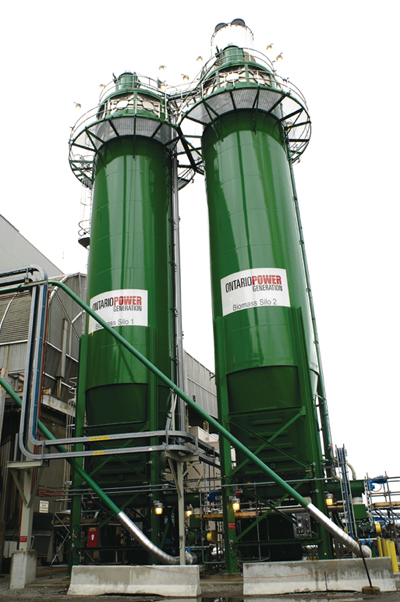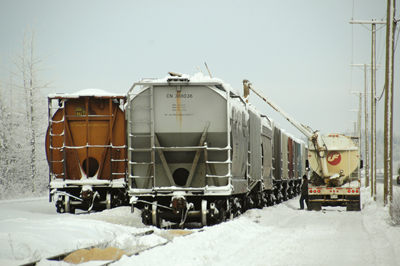
Biomass Power
May 28, 2009
By
Heather Hager
Ontario’s drive to big-time bioenergy is showing both the opportunities
and the limitations of this emerging sector. The Ontario government’s
plans to phase out coal-fired electricity generation are not new.
Ontario’s drive to big-time bioenergy is showing both the opportunities and the limitations of this emerging sector. The Ontario government’s plans to phase out coal-fired electricity generation are not new. In August 2007, the Coal Closure Regulation came into force under the province’s Environmental Protection Act. It mandates both a reduction in carbon dioxide emissions from coal firing starting in 2009 and a complete phase-out of coal by the end of 2014. In anticipation of such measures, Ontario Power Generation (OPG), Ontario’s main electricity supplier, has been evaluating the potential for biomass to replace coal in its four coal-fired stations at Atikokan, Lambton, Nanticoke, and Thunder Bay.
 |
|
| Silos have been installed to feed biomass into a generating unit at Nanticoke.
|
“The carbon dioxide limit applies only to coal,” says Bob Osborne, director of public affairs for OPG’s fossil generation division. “We’ve got plants that Ontarians have paid for, and how can we make use of them? Biomass is a good alternative.”
“There were probably two or three different motivations behind the move to biomass,” says Dr. Chris Young, vice-president of projects for OPG’s Fossil division. “Initially, we started looking at what was happening in Europe with biomass: There was significant use of biomass as a cofiring fuel with coal in the electricity industry. And there was an opportunity to be ‘greener’ than we were, which is important in today’s industry, but particularly if you’re operating a coal-fired plant. Subsequently, the province has moved very strongly away from coal, and that creates an impetus to go to biomass, and if possible, 100% biomass.”
OPG first began by test firing agricultural by-products such as wheat shorts from wheat flour processing and off-grade grain screenings from grain terminals. These are mixed and burned with coal in a cofiring process. “We recognized that wheat shorts would be a cofiring fuel, but if we had to contemplate going to a higher percentage of fuel than about 20%, wood pellets offered the most promise,” explains Young. This is because woody biomass has better chemical characteristics and greater heat content than agricultural by-products. There’s also more of it.
Much of the testing with wood pellets has been performed at the Atikokan generating station in northwestern Ontario because its boiler is better suited for biomass. “Atikokan is a lignite plant, so it’s designed to burn a lower heat-content coal, and the wood pellets are actually a bit better in heat content than lignite,” explains Young. Atikokan’s full electrical output of 211 megawatts has been achieved in short-term trials of burning 100% wood pellets for up to four hours.
In comparison, Nanticoke’s generating capacity is more than 17 times that of Atikokan, at 3640 megawatts, and the boilers are designed to burn higher-grade coal with a higher heat content. This makes it harder to burn 100% biomass. However, OPG has burned 100% wood pellets with natural gas in one of Nanticoke’s eight generating units. “When you start a coal plant, you burn an ignition fuel of oil or natural gas to start the flame. We did a test where the ignition fuel of natural gas was left on and we burned only wood pellets,” says Young. “Our expectation is that we will not be able to achieve the full output at Nanticoke on wood pellets. We believe that the units will be significantly restricted, maybe at about half of normal capability.”
Biomass industry required
One of the main limits to the switch to woody biomass is the availability of wood pellets. For the trials, OPG bought wood pellets from British Columbia, Quebec, and Nova Scotia. Young says that these one-time purchases were made with some difficulty. “We’ve seen slowdowns and shutdowns in the forest industry in general, and the pellets from waste sawdust just aren’t available because there’s little waste sawdust. There’s a need for very substantial change in the forest products industry in Ontario to supply our needs if we are to go this way.”
OPG now buys coal mostly from the U.S., with Thunder Bay and Atikokan using some western Canadian coal. Coal is contracted on intermediate- or long-term contracts, and OPG arranges the transportation to its facilities. Thunder Bay and Atikokan receive shipments by rail, whereas Nanticoke and Lambton receive shipments via lake freighters that are loaded at Great Lakes ports. OPG is considering a similar delivery model for biomass shipments from Ontario sources.
“What we would see happening in Ontario would be the potential for a number of wood pellet mills to be built, and a harvesting industry that supports those pellet mills,” says Young. “What we’d like to do is contract a stable, creditworthy company to supply to us. It will likely be several companies, with the kinds of volumes that we’re contemplating. It’s an opportunity for the forest industry to enter that supply business with us.”
OPG’s switch to wood pellets would benefit the forest industry by creating a stable market and by promoting the development of infrastructure such as pellet mills, proposes Osborne. In mid-January, OPG requested expressions of interest from potential pellet manufacturers within Ontario to assess potential supply capability, volume, quality assurance, and pricing. The process closed in late February
Anticipated pellet volumes
To get an idea of the potential pellet volume, consider that Nanticoke produced approximately 18 billion kilowatt hours of electricity in 2007. At about 600,000 tonnes of wood pellets to produce one billion kilowatt hours of electricity, roughly 10.8 million tonnes of pellets would be required to produce this same amount of electricity. And that doesn’t take into account the other three coal generation plants. Given that the actual wood pellet production in the whole of Canada in 2007 was roughly 1.5 million tonnes, a mere one-seventh of the potential demand of Nanticoke alone, OPG realizes that it is unrealistic to convert all four plants to 100% biomass and still supply the same output.
“We see a future that involves biomass as the main fuel for some of our coal units, but obviously a different role for the plants and a lower capacity in total available,” says Young. Under the current model of electricity supply, nuclear and hydroelectric plants provide the base load of electricity, and the fossil fuel plants are ramped up to fill in the gaps during peak hours. Converted to 100% biomass, these units would still only be fired to fill in gaps during peak hours, but on a much smaller scale.
“We think that there’s about 2 million tonnes of pellets available annually in Ontario. That number reflects the kind of advice that we’ve received from the Ministry of Natural Resources (MNR) and the forest products companies. That translates to a very substantially reduced electricity output,” says Young. “On a rough basis, we think that we could produce about 1/10th of the electricity that the coal plants produced last year, using biomass.”
To meet the demand, biomass would have to be harvested specifically for combustion, and not simply as forest product waste. “It would fit well with the forest strategy of supporting a pulp and paper industry using softwood, with harvesting of low-quality hardwood trees for biomass,” states Young.
OPG is not ruling out a supporting role for agricultural biomass in augmenting the biomass available from the forest sector. “Woody biomass has some attributes that are probably better chemically versus some of the agricultural products, but we would see probably firing a mix of woody biomass and agricultural biomass,” says Young.
Changes and limitations
Pellets are the desired form of biomass because they can be burned without major investment or changes to the furnace system. Typically, the coal is ground and blown into the furnace as a fine dust. “With a pellet, you can take the fine dust pelletized and just break up the pellet to blow it into the furnace in the same way. We run it through exactly the same system,” says Young.
 |
|
| Dr. Chris Young, vice-president of fossil projects, and Bob Osborne, director of public affairs, feel that OPG’s switch to biomass will benefit Ontarians.
|
Likely the biggest change needed is the construction of covered storage to keep the biomass dry. Modifications to unloading systems may be necessary, and some differences in combustion chemistry require attention. “There’s a different air-to-fuel mix required potentially for biomass versus coal, so we may need to alter the airflow systems into the boiler,” explains Young. Also, an additive in the pellet may be required to manage slagging, the buildup of hard ash, in the boilers. “These are relatively minimal changes in terms of the scale of the generating units,” says Young.
Young expects that it will be three or four years before plans are hammered out and fully implemented. “Pellet mills need to be built, we need to undertake some changes in our facilities to ensure that we can store and handle the fuel safely, and we need to work through all of this on a systematic basis,” he says. In the short term, OPG is undertaking engineering research and more biomass trials, as well as discussions with the province regarding changes in the cost structure of electricity associated with burning biomass.
The differences in fuel chemistry between ‘dirty’ coal and cleaner woody biomass provide benefits in the form of reduced acid gas emissions. Sulphur dioxide monitors on the units show low emissions from the wood pellets, and tests to date indicate that nitrogen oxides emissions from wood pellets are lower than those from coal.
The main limitations with biomass are the sheer volume and cost. “Given that we’re fuel limited, we wouldn’t convert all the units to biomass, so the amount of electricity will be less,” says Young. “At Nanticoke, we do not believe we would be successful in getting a unit to run at full load, so we would have less capacity in service by that factor as well. And the cost of biomass is substantially higher than that of coal, so it would be a fuel that we would probably use less than we currently use coal.”
If wood pellets alone are burned at Atikokan or Thunder Bay, something close to the full output of those plants could be achieved, says Osborne. The rub is that Nanticoke cannot be removed from the transmission network easily without the insertion of some other major infrastructure to manage the voltage.
“Nanticoke is at a very critical point on the transmission system,” explains Young. “If you took Nanticoke out of that network, it would cause significant problems, and the network couldn’t survive without some major changes. One of the benefits of biomass is the ability to keep Nanticoke in service supporting that transmission network.”
Still, the benefits of biomass are not to be dismissed lightly. “The real advantage is that we’ve got all of this infrastructure that would have to come out of service unless we can find an opportunity to use it. If you look at natural gas-fired generating stations, just the capital cost of those alone is very significant,” says Young. As an example, he cites the new Portlands Energy Centre in Toronto. This natural gas-fired facility was a $730 million (CAD) investment for 550 megawatts of capacity, which is slightly bigger than one unit at Nanticoke. “You’re potentially avoiding that cost by reusing these facilities.” And even if OPG used more natural gas, that’s still a fossil fuel. “You’ll be paying a carbon cost at some point to do that, probably sooner than later,” says Young.
Burning biomass will allow some of the units to continue to function, maintaining a number of the employees. “Then you’ve got the broader implications for the biomass fuels industry developing in Ontario,” says Osborne. “You’ve got all the jobs and economic benefits of that as well.”
“It’s a good opportunity for Ontario,” concludes Young.
Who provides the pellets? Ontario’s currently unused biomass could become a hot commodity. The Ontario Ministry of Natural Resources (MNR) has estimated that a significant amount of unmerchantable and undersized wood could be harvested annually. In late January, it asked companies to outline their ideas to use this biomass, which could help to support investment and create jobs in Ontario’s forestry sector. Following a review of the submissions, the MNR will determine appropriate next steps, which could include a wood supply competitive process. Concurrently, Ontario Power Generation (OPG) issued a call to potential suppliers of biomass fuel and transportation services to determine the commercial viability of replacing coal with biomass at existing coal-fired generating stations. OPG will use the information about fuel and costs, costs of required plant modifications, and construction of fuel storage and handling facilities to further develop the business case for safe and efficient commercial-scale biomass electricity generation. |
Print this page